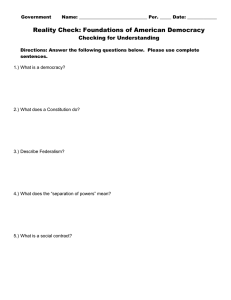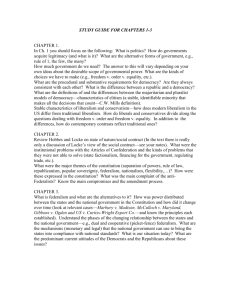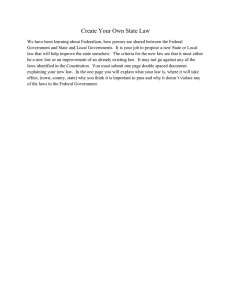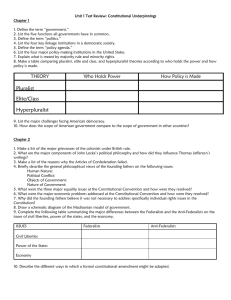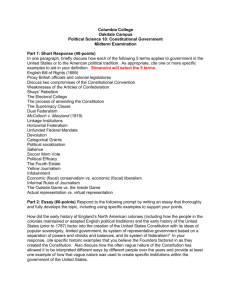Jennybless Lelinu - Study Guide Unit 1 - Political and Economic Structures
advertisement
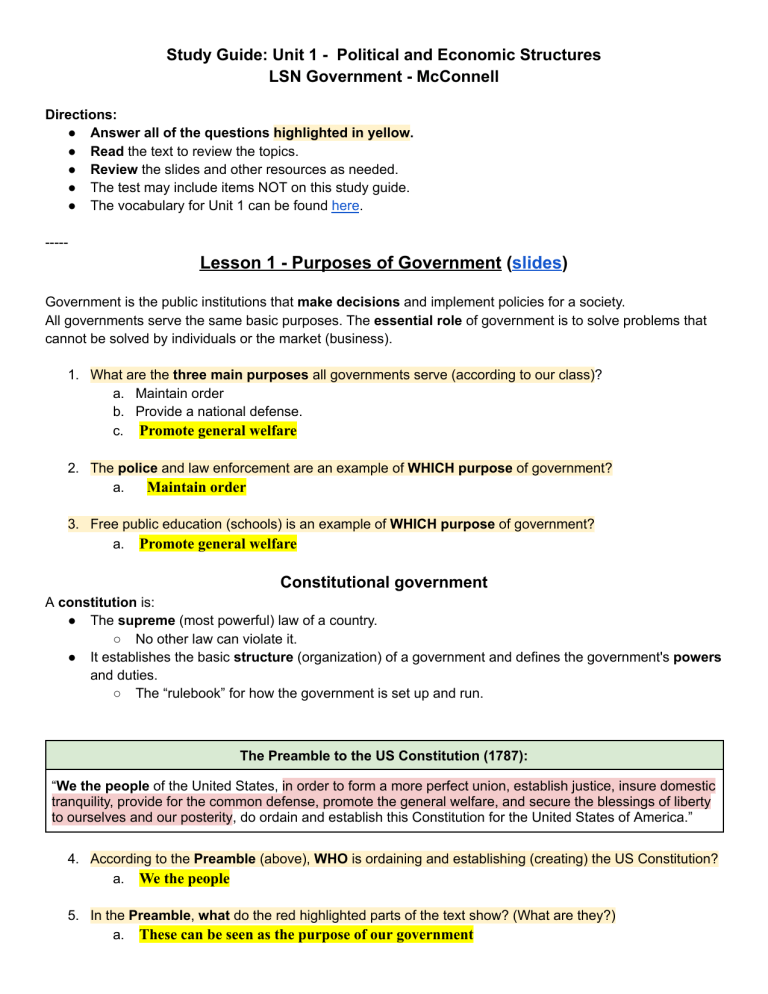
Study Guide: Unit 1 - Political and Economic Structures LSN Government - McConnell Directions: ● Answer all of the questions highlighted in yellow. ● Read the text to review the topics. ● Review the slides and other resources as needed. ● The test may include items NOT on this study guide. ● The vocabulary for Unit 1 can be found here. ----- Lesson 1 - Purposes of Government (slides) Government is the public institutions that make decisions and implement policies for a society. All governments serve the same basic purposes. The essential role of government is to solve problems that cannot be solved by individuals or the market (business). 1. What are the three main purposes all governments serve (according to our class)? a. Maintain order b. Provide a national defense. c. Promote general welfare 2. The police and law enforcement are an example of WHICH purpose of government? Maintain order a. 3. Free public education (schools) is an example of WHICH purpose of government? a. Promote general welfare Constitutional government A constitution is: ● The supreme (most powerful) law of a country. ○ No other law can violate it. ● It establishes the basic structure (organization) of a government and defines the government's powers and duties. ○ The “rulebook” for how the government is set up and run. The Preamble to the US Constitution (1787): “We the people of the United States, in order to form a more perfect union, establish justice, insure domestic tranquility, provide for the common defense, promote the general welfare, and secure the blessings of liberty to ourselves and our posterity, do ordain and establish this Constitution for the United States of America.” 4. According to the Preamble (above), WHO is ordaining and establishing (creating) the US Constitution? a. We the people 5. In the Preamble, what do the red highlighted parts of the text show? (What are they?) a. These can be seen as the purpose of our government The social contract. 6. Who is the social contract made between? a. The social contract is made between the government and a contract between society and the government According to Thomas Hobbes, people gave up some of their rights to the government and in return received order, safety, and protection. According to John Locke, people gave up some of their power to the government and received protection of their natural rights (life, liberty, and property). Natural rights CANNOT be taken away. Everyone has them. 7. Where do natural rights come from? a. From birth Lesson 2 - Forms of Government (slides) Unitary, Confederate, and Federal Systems: You should review how power is held in a unitary, confederate, and federal system. Vocab sheet here. Type of Govt Who holds the power? Unitary National government Confederate State governments Federal Both national and state governments 8. In which types of government (unitary, confederate, or federal) is power most concentrated (held in a small area)? a. Unitary governement 9. In a confederate system, all major government power is held by whom? a. The state Study the definition of each type of government: ● Absolute Monarchy ● Constitutional Monarchy ● Dictatorship ● Representative Democracy (republic) ● Direct Democracy ● Oligarchy Limited vs. Unlimited Government: Limited government is constitutional government. A government whose power is controlled by a constitution is a limited government. 10. What is the difference between an absolute monarchy and a constitutional monarchy? a. In an absolute monarchy, the power of the king or queen is unlimited b. In a constitutional monarchy, the power of the king or queen is limited through a country’s constitution 11. When we say that a government’s power is “limited,” what is it limited by? a. The government’s power is limited by the constitution Democracy vs. Authoritarianism: Review the advantages and disadvantages of democracy (link). Review the advantages and disadvantages of authoritarianism. 12. There are advantages and disadvantages to democracy and authoritarianism. Fill in this chart Advantages Disadvantages Democracy Respect of human rights Slow decision-making Authoritarianism Quick decision-making Do not respect human rights - Direct Democracy vs. Representative Democracy: Direct Democracy: - People debate and vote directly on laws. - Representative Democracy (also called a “republic”): - Voters elect others to create laws and run the government on their behalf. Lesson 3 - Federalism (slides) Federalism: A system of government in which the authority of government is shared by and divided between national and state governments. 13. How does this chart (above) relate to the concept of federalism? Explain your thinking. (1-2 sentences). a. The chart shows how power is distributed among the state and national government and it also shows some of the power’s both state and national government share together b. This relates to federalism because federalism is a form of government where authority and power is being shared and divided among the national and state government. Some Powers Granted by the Constitution… To the National Government To Both the National AND State Governments To the State Governments ● ● ● ● ● ● ● ● Coin Money Conduct Foreign Relations Regulate commerce with foreign nations and among states Provide an army and navy Declare war Establish courts inferior to the Supreme Court Establish Post offices Make laws necessary and proper to carry out the forgoing powers. ● ● ● ● ● Tax Borrow Money Establish courts Make and enforce laws Spend money on the general welfare ● Regulate commerce (business) within a state. Conduct elections Ratify amendments to the US Constitution Exert powers the Constitution does NOT delegate to the national government or prohibit the states from using. ● ● ● Some Powers Denied by the Constitution… To the National Govt ● ● ● Tax articles exported from one state to another Violate the Bill of Rights Change state boundaries To Both the National AND State Governments ● ● ● ● Grant titles of nobility Permit Slavery (13th Amendment) Deny Citizens the right to vote based on race, color, or previous servitude (15th Amendment) Deny citizens the right to vote based on gender and/or sex (19th Amendment). To the State Governments ● ● ● ● Tax imports or exports Coin money Enter into treaties with foreign countries Abridge the privileges or immunities of citizens or deny due process and/or equal protection (14th amendment). 14. According to the charts above, in the United States, which part of the government has the power to tax? a. Both part of the governmenthas the power to tax 15. There are advantages and disadvantages to federalism. Fill in this chart (below): Advantages Disadvantages Federal System: power shared between national and state govts Makes everyone participate in the decision-making process to urther better the country/ economy Hard to coordinate response to issues (example COVID response in the US). Unitary System: power held only by national govt Easy to coordinate Singular decision-making authority Detached from local needs Confederate System: power held Local decision-making. Hard to coordinate by states ● Review the federalism video. ● Federalism Cartoon: ○ Be prepared to explain what this cartoon is saying. 16. According to this cartoon, what do the states WANT from federalism? a. The states want federal benefits 17. According to this cartoon, what do the states NOT accept from federalism? a. The states reject federal authority Lesson 4 - Economic Systems and Principles (slides) ● Review the vocabulary sheet (Click the link) Four Types of Economies Traditional Economy: An economy based on historic customs (practices). Mostly subsistence farming = you produce just enough to survive. What you produce is primarily used for you and your family, not sold to others. Market Economy (Free market): an economic system where buyers and sellers determine supply, demand, and prices. Command Economy: an economic system where the government controls what is produced and in what quantity (supply) and controls or sets prices. Mixed-Market Economy: An economic system where the free market mostly determines supply, demand, and prices but the government creates rules and regulations and may get involved in certain industries (like power). Market Economy Command Economy Mixed Market Economy What determines prices? Supply and Demand Government policy Mostly supply and demand. Government can for certain issues. Who sets prices? Buyers and Sellers The government Mostly buyers and sellers. Government may control certain prices. (For example, healthcare). Who decides WHAT to produce? Producers (individuals, businesses). The government Mostly producers. The government may produce certain things or require businesses to produce certain things at times (such as during war). Who owns the means of production (land, energy grid, natural resources, factories)? Private individuals or companies The government Most things are private. But the government may get involved in some areas (ex. electric grid, water, public housing). 18. Which type of economy has the MOST government control? Which type of government has the LEAST government control? a. The type of economy with the MOST government control is command economy b. The type of economy with the LEAST government control is market economy 19. How is a market economy different from a command economy? a. In a market economy, SUPPLY and Prices are determined by supply and demand b. In a command economy, SUPPLY and PRICES are determined by the government Opportunity Cost: ● Opportunity cost is the value of the next-best alternative when a decision is made. ● The benefit you give up by choosing to do one thing instead of another. ● Example: If you only have 3 hours before you need to go to bed and you spend the 3 hours playing video games instead of studying, you gave up the opportunity to study. ○ The opportunity cost of playing video games was 3 hours of study time. ● Video: https://www.youtube.com/watch?v=x-hYzRncxTc 20. If a local government decides to spend $1 million on hiring more police officers, what is a possible opportunity cost of this decision? a. They could use that money to help further develop the economy. Thye could like build schools, give home for homeless, build more orphanages, more hospitals and other facilities we need in the community.
